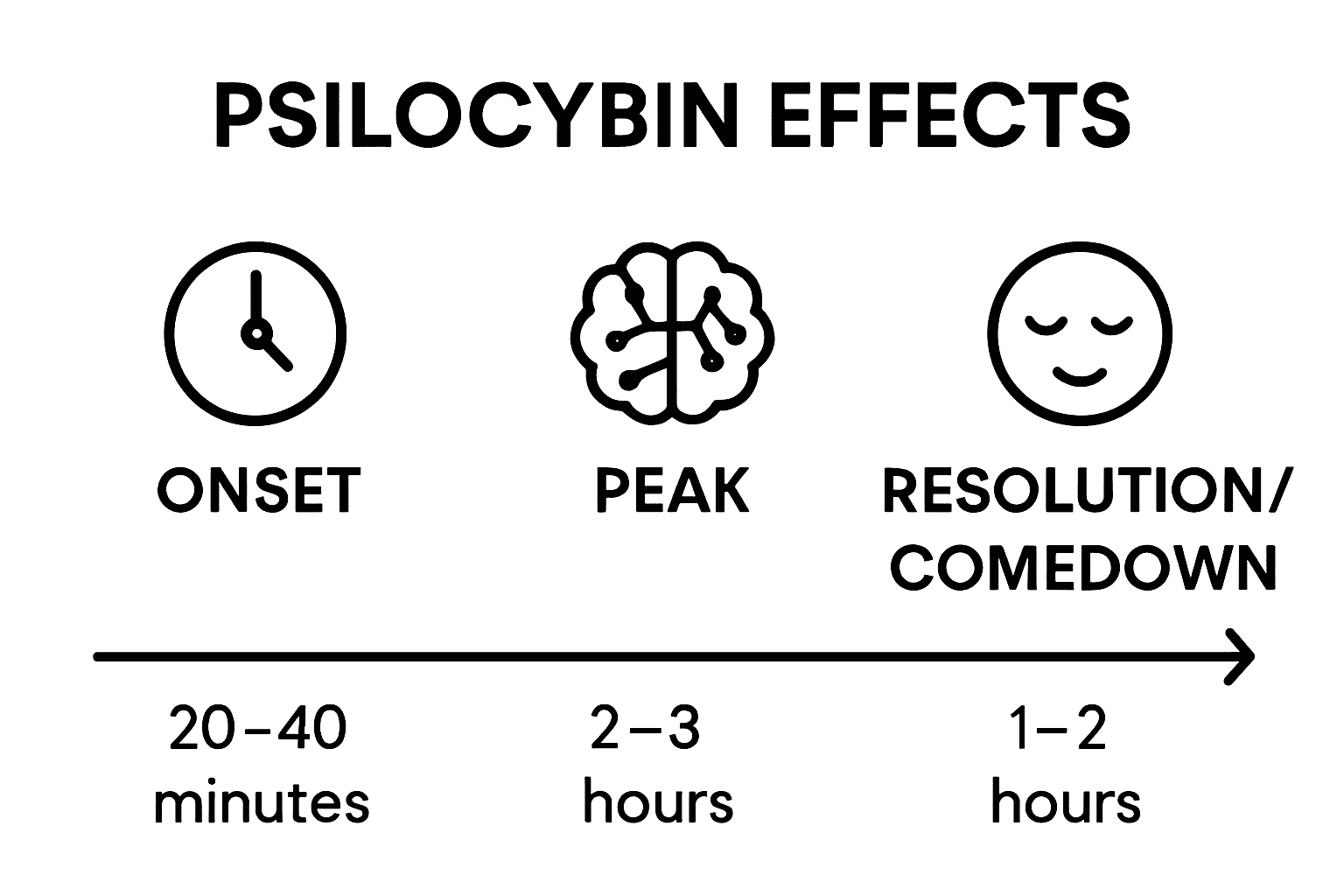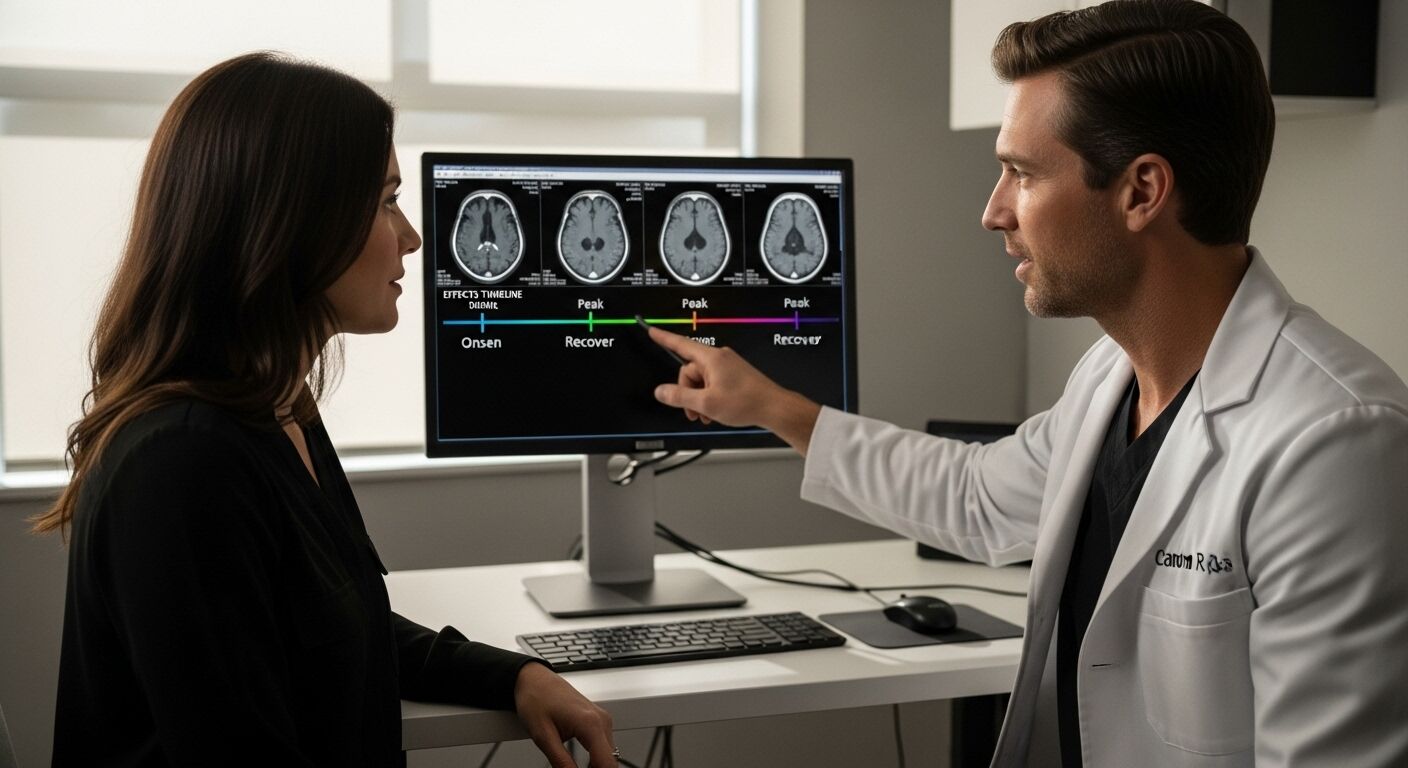Psilocybin is making headlines for its startling effects on the human mind and is turning age-old magic mushrooms into serious scientific subjects. Researchers have found that psilocybin can reduce activity in the brain’s default mode network and boost communication between brain regions that rarely connect. Most people expect these mushrooms to just cause trippy visuals and distortion. The real surprise is that these temporary brain changes might be why psilocybin shows strong promise for treating depression, anxiety, and addiction.
Table of Contents
- What Is Psilocybin And How Does It Affect The Brain?
- The Phases Of Psilocybin Effects: From Ingestion To Peak
- Why Understanding The Psilocybin Effects Timeline Matters
- Real-World Applications Of Psilocybin: Therapeutic And Recreational Use
Quick Summary
| Takeaway | Explanation |
|---|---|
| Psilocybin alters brain connectivity. | It disrupts the default mode network, leading to new communication between brain regions, affecting perception and mood. |
| Understand the phases of psilocybin effects. | The experience involves distinct stages, from onset (20-40 minutes) to peak (60-90 minutes), crucial for managing the journey. |
| Psilocybin shows therapeutic potential for mental health. | Research indicates effectiveness in treating depression, PTSD, addiction, and anxiety, suggesting new treatment avenues. |
| Intentional use enhances personal exploration. | Controlled, mindful consumption can lead to insights, emotional growth, and creative breakthroughs beyond clinical applications. |
| Safety and preparation are essential. | Knowledge of effects allows participants to create a supportive environment, prep for challenges, and reduce risk. |
What is Psilocybin and How Does It Affect the Brain?
Psilocybin is a naturally occurring psychoactive compound found in certain species of mushrooms, often referred to as “magic mushrooms” or “shrooms”. This fascinating molecule belongs to a class of compounds known as psychedelics, which can profoundly alter human perception, cognition, and emotional experience.
The Chemical Composition and Origin
Found primarily in mushroom species of the Psilocybe genus, psilocybin is a prodrug that transforms into psilocin once metabolized by the human body. These mushrooms have been used for centuries in indigenous spiritual and healing practices across various cultures, particularly in Central and South America. Research from the National Institutes of Health reveals that psilocybin has unique neurological effects, temporarily disrupting the brain’s default mode network responsible for self-referential thinking.
Neurological Interactions and Brain Impact
When ingested, psilocybin interacts with serotonin receptors in the brain, specifically the 5-HT2A receptors. This interaction triggers a cascade of neurological changes that can lead to significant shifts in consciousness. The compound’s effects include:
- Reduced activity in the brain’s default mode network
- Increased communication between brain regions that typically do not interact
- Temporary alterations in perception, mood, and cognitive processing
These neurological changes explain why individuals experiencing psilocybin’s effects often report profound insights, emotional breakthroughs, and a sense of interconnectedness. If you’re interested in exploring how psilocybin might support mental wellness, read more about its potential for natural mental health solutions.
Understanding psilocybin’s complex interaction with the brain reveals why researchers are increasingly studying its potential therapeutic applications for conditions like depression, anxiety, and addiction. The compound’s ability to temporarily restructure brain connectivity offers promising avenues for mental health treatment and cognitive exploration.
The Phases of Psilocybin Effects: From Ingestion to Peak
The psilocybin experience is a complex journey characterized by distinct neurological and perceptual phases that unfold systematically after consumption.
Understanding these phases helps individuals anticipate and navigate the transformative experience more effectively.

Onset Phase: Initial Neurological Shifts
The onset phase begins approximately 20 to 40 minutes after ingestion, marking the first subtle indications of psilocybin’s impact. During this initial stage, individuals may experience gentle changes in sensory perception, including slight alterations in color vibrancy, enhanced texture sensitivity, and mild emotional fluidity. Research from the journal Neuropharmacology indicates that these early effects result from psilocybin’s metabolization into psilocin, which begins interacting with serotonin receptors in the brain.
Peak Experience: Intense Neurological Transformation
The peak phase typically occurs between 60 to 90 minutes post-consumption, representing the most profound period of neurological and perceptual transformation. Key characteristics of this phase include:
- Significant alterations in consciousness and self-perception
- Intense visual and auditory hallucinations
- Deep emotional experiences and potential psychological insights
- Temporary dissolution of typical ego boundaries
This intense period reflects the compound’s ability to dramatically restructure brain connectivity, creating unprecedented neural communication pathways. If you want to explore safe consumption strategies, check out our microdosing schedule guide.
Ultimately, the psilocybin experience is a highly individual journey, with duration and intensity varying based on dosage, personal physiology, and psychological state.
To clarify how psilocybin’s effects progress over time, the table below outlines the main phases after ingestion and the typical experiences reported during each stage.
| Phase | Timing After Ingestion | Key Experiences and Effects |
|---|---|---|
| Onset | 20-40 minutes | Subtle sensory changes, enhanced texture and color, mild shifts in emotion |
| Peak | 60-90 minutes | Intense alterations in consciousness, strong visuals/auditory effects, deep emotions, ego dissolution |
| Individual Variation | Varies | Duration/intensity can shift based on dose, physiology, mindset |
| Professional guidance and a supportive environment remain crucial for those considering this profound neurological exploration. |
Why Understanding the Psilocybin Effects Timeline Matters
Knowledge of the psilocybin effects timeline is crucial for ensuring safe, intentional, and meaningful psychedelic experiences. This understanding extends beyond mere curiosity, offering profound insights into personal psychological exploration and potential therapeutic applications.
Personal Safety and Psychological Preparedness
Comprehending the progression of psilocybin’s effects allows individuals to create a supportive environment and manage potential psychological challenges. Knowing when and how intense experiences might emerge helps participants prepare mentally and physically, reducing the likelihood of overwhelming or traumatic encounters. Research from the National Institutes of Health demonstrates that understanding neurological shifts can significantly impact the overall psychedelic experience.
Therapeutic and Wellness Potential
The timeline of psilocybin effects reveals critical windows for potential therapeutic interventions. Researchers and mental health professionals are increasingly exploring how specific phases of the psychedelic experience can be leveraged for psychological healing. Key considerations include:
- Identifying optimal moments for therapeutic breakthrough
- Understanding the neurological mechanisms of emotional processing
- Recognizing potential long-term psychological impacts
- Mapping individual variations in psychedelic responses
If you’re curious about the potential side effects and wellness considerations, explore our comprehensive guide on psilocybin wellness.
Ultimately, the psilocybin effects timeline is not just a scientific curiosity but a gateway to understanding human consciousness, emotional resilience, and the intricate connections between neurochemistry and subjective experience. By demystifying these phases, individuals can approach psychedelic experiences with greater wisdom, intentionality, and respect for the profound neurological journey they are about to undertake.

Real-World Applications of Psilocybin: Therapeutic and Recreational Use
Psilocybin has emerged from the shadows of counterculture to become a fascinating subject of scientific research, with applications spanning therapeutic interventions and personal exploration. The compound’s versatility offers potential solutions for mental health challenges while simultaneously providing profound experiences of consciousness.
Therapeutic Interventions and Mental Health
In recent years, clinical research has highlighted psilocybin’s remarkable potential in treating various mental health conditions. Research from the National Institutes of Health demonstrates significant efficacy in addressing complex psychological challenges. Therapeutic applications include:
- Treatment-resistant depression
- Anxiety associated with terminal illness
- Addiction and substance use disorders
- Post-traumatic stress disorder (PTSD)
- Potential neuroplasticity enhancement
Professional guided therapy sessions leverage psilocybin’s unique ability to temporarily disrupt rigid cognitive patterns, allowing individuals to process emotional experiences from novel perspectives. If you’re interested in exploring therapeutic approaches, learn more about psilocybin’s potential for social anxiety relief.
Recreational and Personal Exploration
Beyond clinical settings, individuals use psilocybin for personal growth, spiritual exploration, and enhanced creativity. Recreational use emphasizes intentional, controlled experiences that can provide:
- Profound insights into personal psychology
- Enhanced emotional awareness
- Temporary dissolution of ego boundaries
- Potential breakthrough in creative thinking
While recreational use remains complex from a legal standpoint, the growing body of research continues to reshape societal understanding of psilocybin’s potential benefits and risks.
Here is a table summarizing the key therapeutic and recreational applications of psilocybin, highlighting primary uses and outcomes as described in the article.
| Application Type | Primary Uses | Potential Outcomes |
|---|---|---|
| Therapeutic | Treating depression, anxiety, PTSD, addiction, and end-of-life distress | Emotional healing, cognitive flexibility, neuroplasticity enhancement |
| Recreational | Personal growth, spiritual exploration, enhanced creativity | Profound insights, emotional awareness, creative breakthroughs |
Ready to Manage Your Psilocybin Journey with Clarity?
If understanding psilocybin’s complex effects timeline felt overwhelming, you are not alone. Many readers seek predictable ways to unlock mental wellness and cognitive support while maintaining day-to-day balance. At Kind Stranger, we focus on gentle microdosing protocols so you can access the benefits of psilocybin without the intensity described in peak experiences. Dive deeper with our MICRODOSING resource hub for easy-to-follow schedules and science-backed dosing information.

Why wait to make your wellness routine work for you? Safely explore microdosed psilocybin capsules and gummies designed for sustained focus, brighter mood, and creative energy. Visit Kind Stranger to browse our carefully curated products, discover FAQs on legality and safety, and take the first step toward balanced plant-based wellness. The knowledge from your reading is just the beginning. Make your next move with confidence.
Frequently Asked Questions
What is psilocybin, and how does it affect the brain?
Psilocybin is a naturally occurring psychoactive compound found in certain mushrooms. It alters perception, cognition, and emotions by interacting with serotonin receptors in the brain, leading to changes in consciousness and emotional experiences.
How long does it take for the effects of psilocybin to begin?
The onset of psilocybin effects typically begins 20 to 40 minutes after ingestion, with users experiencing initial sensory changes and emotional fluidity before entering the peak experience.
What happens during the peak phase of a psilocybin experience?
The peak phase occurs 60 to 90 minutes after consumption and is characterized by intense alterations in consciousness, visual and auditory hallucinations, emotional experiences, and temporary dissolution of ego boundaries.
Why is understanding the psilocybin effects timeline important?
Understanding the timeline is crucial for personal safety and psychological preparedness, as it helps individuals manage potential challenges and enhance the therapeutic benefits of psilocybin experiences.
Recommended
- Psilocybin Side Effects: What Wellness Seekers Need to Know 2025 • KIND STRANGER
- Psilocybin Withdrawal Symptoms: What to Expect in 2025 • KIND STRANGER
- Psilocybin Microdosing Schedule Guide 2025: Safe and Effective Plans • KIND STRANGER
- Psilocybin for Social Anxiety: Natural Relief in 2025 • KIND STRANGER


Comments
There are no comments yet.